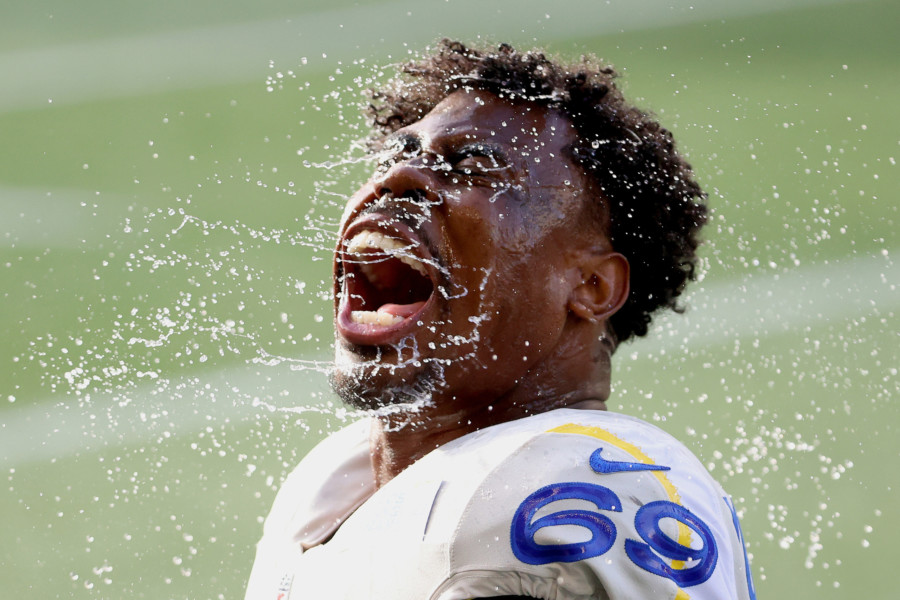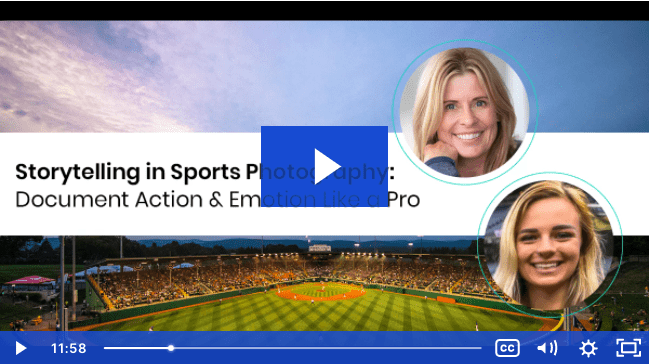Share
WATCH: Visual Storytelling in Sports Photography
Sports photography is full of exciting action, raw emotion and powerful moments that live on well beyond the shot clocks, time-outs and commercial ...

Sports photography is full of exciting action, raw emotion and powerful moments that live on well beyond the shot clocks, time-outs and commercial breaks.
For Abbie Parr and Jean Fruth, covering sports isn’t just about documenting unbridled passion and once-in-a-lifetime moments. It’s also a chance to celebrate a community of dedicated champions, enthusiasts, creatives and more.
In our conversation with these two talented sports photographers, we took an inside look at some of their favorite photos while talking through actionable tips for fellow sports photographers looking to make an impact with their own work.
Cover photo by Abbie Parr
See the full on-demand recording below and read on to learn:
- How to showcase emotion and action in your images
- Sports photo tips and tricks Abbie and Jean have gathered during their careers
- Advice on succeeding in the world of sports photography
Our Q&A with Abbie and Jean
Thank you to everyone for submitting questions for Abbie and Jean. Have any additional questions? Tweet us @photoshelter and let us know!
This Q&A was edited for clarity and length.
What advice do you have for other women sports photographers looking to make the jump from photographing amateur sports to professional sports?
Abbie Parr: I always think it’s really important to get to know the photographers around you, because a lot of times the photographer sitting right next to you can be a stranger and then the next day they can be your coworker. They can refer to you for assignments. And a lot of times, the photographers who I’ve gotten to know, they’re the ones who refer me to editors, think of me for ideas, etc.
I’ve learned so much just from the photographers around me. They’ve taught me so many things I wouldn’t have been able to learn for myself, like shooting cool examples of light or shooting with remotes.
So don’t be afraid to just say hello to the photographer next to you at a game and say, “Hey, I see you’re shooting for so and so, I would love to know if you are able to introduce me to your editor. Do you mind looking at my photos at the end of the night and let me know if you have any suggestions for improvement?” I think that taking the time to get to know people not only just makes games more fun and exciting, but you can also meet some people who can really help you advance your career.
Jean, a lot of people are interested in hearing about your new book. What’s upcoming for you? Tell us about any exciting projects that you have planned.
Jean Fruth: When my first book came out, Grassroots Baseball: Where Legends Begin, it was about the amateur game around the world, tied in with Hall of Famers telling their stories of what it was like growing up in these different regions. After that, I wanted to do more at this point in my life and in my career where I’m fortunate enough to be able to give back. That’s really where everything is heading for me. I want to give back to my craft. I want to give back to the sport I love and just surround my work with purpose and Grassroots Baseball. I’m happy to say some good things came out of COVID and we are now officially a nonprofit. It’s exciting for me to be able to take my work in that direction.
So we are doing clinics with kids. We connected with the Boys and Girls Club, and we started the journey of the not for profit along Route 66. I just thought what a great place it would be to give back in such an Americano way. As you know, it starts in Chicago and ends in Santa Monica. I did portraits of every kid, they got a new Rawlings baseball glove, they got to play catch and have a clinic with a Hall of Famer or retired player along the route. And three years later, a book, Grassroots Baseball: Route 66, will be out at the end of next month. So I’m really excited about having that project complete.
Our next project is Women in Baseball; On the field and off the field, past, present and future. We’re telling the stories and celebrating the women who are in baseball in all aspects of the game.
Directing video is also new for me. So this project will be a big learning experience. And it’s a three year project because I like the idea of going deep on a subject, like I did with Route 66. You really learn so much more by doing something a little bit longer. I’m still shooting the professional game and shooting Major League Soccer and Baseball and all of that. But having a project where you can sink your teeth into and go deeper is really rewarding as a photographer.
People are curious, Abbie… How did you get to photograph the Olympics? What’s the process there? Can you take us behind the scenes of that global phenomenon, and being a photographer there?
AP: My first Olympics was Tokyo and that was entirely possible because of a program I did, the Young Reporters Program. That was through the International Olympic Committee. They took, I believe it was, three females around the ages 21 to 24. It was something you applied for and if you got picked, you got to go to Argentina and photograph the Youth Olympics. And you were mentored by all these really awesome photographers, too. I was led by Bob Martin. That was so cool because I really haven’t been out of the country at all.
I remember a couple of the photographers were there previously, photo chiefs at some of the Olympic games too, which was a big deal. So that was how I got my first taste of the Olympics. Then, at the end of that program, we were all granted freelance credentials to go to Tokyo, so I ended up freelancing in Tokyo for Getty. That was quite the experience, with COVID and everything. Definitely not how I imagined my first Olympics, being in a bubble. But it doesn’t matter to me, I got to go to the Olympics. That was my dream come true. Everything I shoot back here at home, it was working towards being able to shoot something like the Olympics.
Both of you have explained major successes and exciting opportunities. Do you have any major assignment failures that you’ve learned from?
JF: One of my first postseasons, I was nervous. You’re with very experienced photographers who you look up to, they’re your heroes and now you’re shooting side by side with them. There was a moment that happened, I missed the moment I should have captured. Is that a failure? No. The failure was not getting it out of my head fast enough. It happens. If you let it spin your head, you’re going to miss the next moment and then the next.
So as sports photographers, you miss. You try not to miss, but you miss. And if you miss, you’ve got to throw it in the garbage as quickly as possible, just like an athlete. If a football player misses the catch, if he lets that bother him, he’s going to miss the next catch. If you let your failures, as you’re shooting, get in your head, you’re not going to be able to do well for the rest of your shoot. So you have to be disciplined.
AP: I think back to that very first picture [shown in the presentation]. It took me, I think, five or six tries to capture that image. I like what Jean said about how it’s mentally tough when you fail and you think, “Oh my God, I would do anything to go back and to have that moment again.” I think that it’s important in this industry to find a balance between, “Okay, I’m really upset. I missed this moment. It’s gone. It’s not happening again” but also sort of take that and make something out of that feeling. I hate thinking, “Oh my God, I just missed that moment. And I don’t want to think that again. I don’t want to experience this again. So this is going to motivate me and I’m going to turn a negative into a positive, and I’m going to learn from this.”
If you miss a moment, the person right next to you, they could nail that moment. And you go back into the photo room, you see everyone’s computer screens and they all have the moment that you wanted, it’s the worst feeling ever. So I just think that you have to learn how to take that disappointment and make something of it and make sure that you don’t have to experience that again because the next chance that you have, you’re going to be ready for it.
If you want to dive into more of Abbie and Jean’s tips for photographers and words of encouragement – plus a detailed look at several of their stunning photos – watch the full on-demand webinar below!
Full on-demand recording




